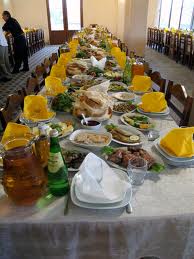“We are not only what we eat, but how we eat, too.” – Michael Pollan
 “According to Georgian legend, God took a supper break while creating the world. He became so involved with his meal that he inadvertently tripped over the high peaks of the Caucasus, spilling his food onto the land below. The land blessed by Heaven's table scraps was Georgia” (The Georgian Feast).
“According to Georgian legend, God took a supper break while creating the world. He became so involved with his meal that he inadvertently tripped over the high peaks of the Caucasus, spilling his food onto the land below. The land blessed by Heaven's table scraps was Georgia” (The Georgian Feast).
 “According to Georgian legend, God took a supper break while creating the world. He became so involved with his meal that he inadvertently tripped over the high peaks of the Caucasus, spilling his food onto the land below. The land blessed by Heaven's table scraps was Georgia” (The Georgian Feast).
“According to Georgian legend, God took a supper break while creating the world. He became so involved with his meal that he inadvertently tripped over the high peaks of the Caucasus, spilling his food onto the land below. The land blessed by Heaven's table scraps was Georgia” (The Georgian Feast).Any foreigner who ever has been in Georgia will tell you that it would be a crime to miss out on the most quintessential Georgian experience, the supra. A Georgian Supra is a celebratory feast (banquet). We, Georgians, take our eating seriously, but even more so when it comes to celebration. There are various levels of formality in a supra. The most formal supras usually mark weddings, baptisms, birthdays, Easter, Christmas, housewarmings or funerals. But usually we can find any reason to get together and celebrate, because the main reason for supra is not the consumption of food but a human interaction.
The supra is usually held at a single long table, or a string of tables running end to end. When the guests arrive, most of the food is already set out. The food varies by region, but almost always includes chicken and ham, different vegetables with walnuts, salads, assorted cheese, fish, walnut and plum sauces, beans, and fresh greens such as parsley, spring onion, tarragon, radish, or watercress. As the supra goes on, more hot food is brought out--lamb stew (chakapuli), Cheese bread (khachapuri), and Georgian dumplings (khinkali). The food keeps coming, but the serving plates are not removed; so, by the end of the meal, the plates of food are literally stacked on top of each other. At the end of the meal, the host brings out sweets for desert.
 There is no supra without wine; it’s as important as the food. Georgians claim that we are a country of winemaking. In his book “Georgia” Tim Burford writes,
There is no supra without wine; it’s as important as the food. Georgians claim that we are a country of winemaking. In his book “Georgia” Tim Burford writes,”There’s been wine in Georgia almost as long as there have been Georgians: around 6,000-7,000 years. Wine is absolutely central to the Georgian lifestyle and to their self-image...There are at least 500 varieties of grape in Georgia, with up to 38 in common use” (Burford, p.71-72).
Wine is considered a holy drink (it has energy of sun, energy of earth and energy of a person who made it) and maybe because of this wine is never drunk without toasting.
Every and any time where wine is to be consumed, even if only two men are present. One of them is appointed to be toastmaster (tamada). An ideal tamada must have the skills of an orator, a poet, a philosopher, a social commentator, a singer, and also good drinker.
He is expected to give deep, meaningful toasts and keep the supra-goers entertained at all times. Most importantly, the tamada must always drink the most at the table but can never act drunk.
This is how Kevin Tuite from University of Montreal describes supra etiquette,
” No wine is to be consumed unless a toast (sadγegrdzelo) has first been pronounced by the drinker. But that is far from all: Each round of drinking begins with a toast on a particular topic declaimed by the tamada, after which he – and only he – drinks. After the toastmaster finishes, the other guests, one after the other, give toasts of their own on the same theme, then each of them drinks. Furthermore, each drinker, ideally, should drink ALL of the wine in his drinking vessel (glass, horn, or whatever it might happen to be) in a single draught. In practice, only the tamada is obliged to adhere to this rule, but the other men strive to consume at least half of the wine in their glasses. Although the toastmaster chooses the subject of each round of toasts, his choice is by no means free. The order of toasts, especially in the opening phase of the banquet, follows a quite rigid sequence, although the exact order followed depends on the type of occasion, and also the region of Georgia where the banquet takes place. Anywhere from three (the absolute minimum, to my knowledge) to three dozen or more rounds of toasts may occur during a single banquet. A typical evening supra in a private home might go on for three or four hours, though banquets lasting from 7 or 8 pm until 3 o’clock or later at night are not at all rare.”
” No wine is to be consumed unless a toast (sadγegrdzelo) has first been pronounced by the drinker. But that is far from all: Each round of drinking begins with a toast on a particular topic declaimed by the tamada, after which he – and only he – drinks. After the toastmaster finishes, the other guests, one after the other, give toasts of their own on the same theme, then each of them drinks. Furthermore, each drinker, ideally, should drink ALL of the wine in his drinking vessel (glass, horn, or whatever it might happen to be) in a single draught. In practice, only the tamada is obliged to adhere to this rule, but the other men strive to consume at least half of the wine in their glasses. Although the toastmaster chooses the subject of each round of toasts, his choice is by no means free. The order of toasts, especially in the opening phase of the banquet, follows a quite rigid sequence, although the exact order followed depends on the type of occasion, and also the region of Georgia where the banquet takes place. Anywhere from three (the absolute minimum, to my knowledge) to three dozen or more rounds of toasts may occur during a single banquet. A typical evening supra in a private home might go on for three or four hours, though banquets lasting from 7 or 8 pm until 3 o’clock or later at night are not at all rare.”
For a while now, I am trying to find the answer to a question – what purpose does all this strict traditions at the Georgian supra serve? I read somewhere that cultural traits are usually reactions against something. Therefore, culture can be understood as a reaction against one thing and in favor of some other thing. I wondered what the explanation of Georgian obsession is for supra. It’s not love of food as such, or drinking for main purpose to become drunk. Supra is a way of communication through consumption of food and drink. But what is underlying purpose? And I found answer in Florian Muehlfried’s book “Post-Soviet feasting – the Georgian Banquet in transition” (unfortunately book is only in German not in English).
According to Muehlfried Georgian supra became especially important in the 19th century, when Georgian kingdom became protectorate of Russian empire, and afterwards in the Soviet times. He argues that the Georgian supra was a major way to provide secondary education. Tsarist Russia first, and then Soviet official institutions were suppressing Georgian culture, its, oral history, Georgian way of life, and development of Georgian identity. Schools were dominated by Russian superstructures. And supra became “a very important vehicle that helped preserve this oral history.” Supra was the way to channel knowledge and values through generations - people talked about history, national heroes, folk, and rituals. Through tradition of supra we managed to preserve unique Georgian cuisine, diversity of food and wine, songs and dances. It was a way to protect Georgia’s past, traditions and identity.
Muehlfried believes that Georgian identity was set against Russian identity, and supra, as we know it today was developed as the way of coping with oppression. “On an official level, national identity was suppressed. Thus, on a sub-cultural level, people reacted and paid more attention to practices like the supra, and these practices became more important “(Muehlfried). I heard so many times from our elders that Georgian supra is an academia where we learn from each other. But only now, being so far away from my motherland I see the deep meaning of those words.
In his article “Home Grown” Brian Halweil mentions Slow Food Movement. On their web-site one can read “Slow Food stands at the crossroads of ecology and gastronomy, ethics and pleasure. It opposes the standardization of taste and culture, and the unrestrained power of the food industry multinationals and industrial agriculture. We believe that everyone has a fundamental right to the pleasure of good food and consequently the responsibility to protect the heritage of food, tradition and culture that make this pleasure possible. Our association believes in the concept of neo-gastronomy - recognition of the strong connections between plate, planet, people and culture.” Looks like Georgian supra has internal agreement with the Slow Food Movement and really played its role in saving my culture. But will it be strong enough to withstand pressure of the Fast Food industry?
Reference:
Brian Halweil – Home Grown. Worldwatch Paper 163. November 2002.
Florian Muehlfried – “Post-Soviet Feasting – the Georgian Banquet in Transition” - http://www.amazon.com/Postsowjetische-Feiern-Georgische-Post-Soviet-Politics/dp/3898216012/ref=sr_1_1?ie=UTF8&s=books&qid=1287453238&sr=8-1
Kevin Tuite – “The autocrat of the banquet table: the political and social significance of the Georgian supra.” http://docs.google.com/viewer?a=v&q=cache:wj6QfLW-iVwJ:www.mapageweb.umontreal.ca/tuitekj/publications/Tuite-supra.pdf+kevin+tuite+georgian+supra&hl=en&gl=us&pid=bl&srcid=ADGEESgFpMyV1AXC9p6RiVDzEctEYLN8sXkmSifvlHp4UtuvvQOMos8JPsrHNvl7VlNzg5uTbY0zHGXKMoLWesG1PbPoSSPxsW8cmymxMilJDSJigyJ4MvyYlclS0JtssRuhBA9bTJsf&sig=AHIEtbRcey6THvlNW0zi8g41hhLisN1ajQ
Michael Pollan – “Omnivore’s Dilemma”
The Georgian Feast - http://www.ucpress.edu/book.php?isbn=9780520219298












